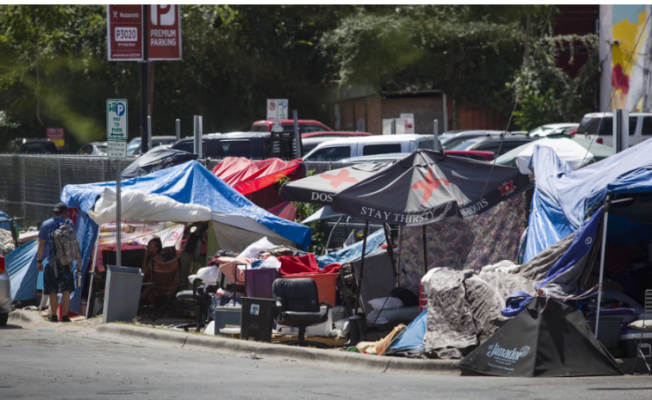Unpacking the Federal Report’s Findings and Navigating the Complex Landscape of Homelessness in the Lone Star State
The Lone Star State, known for its vast landscapes and resilient communities, is facing an escalating crisis that demands urgent attention — the alarming surge in homelessness, especially among veterans. The recently released 2023 report by the U.S. Department of Housing and Urban Development (HUD) unveils unsettling statistics, painting a grim picture of the challenges faced by the homeless population in Texas.
Rising Numbers: A Disturbing Trend
In late January 2023, Texas witnessed a disheartening 13% increase in the overall number of people experiencing homelessness compared to the previous year. The figures, a stark jump from 24,432 in 2022 to 27,377 in 2023, underscore the pressing need for comprehensive solutions to address the root causes of homelessness.
Contrary to the positive trend observed from 2020 to 2022, where homelessness in Texas decreased by 10%, the recent surge raises concerns about the evolving dynamics contributing to the crisis. The HUD report delves into the granular details of this surge, revealing a specific and troubling increase in homelessness among veterans.
Veterans Bear the Brunt: A 19% Spike
One of the most distressing aspects highlighted in the HUD report is the significant surge in homelessness among veterans in Texas. The numbers reveal a staggering 19% increase, translating to 325 additional veterans grappling with homelessness from 2022 to 2023. San Antonio and Dallas, two major cities, emerged as significant contributors, accounting for over one-third of this concerning spike.
While acknowledging this recent surge, it’s crucial to recognize the strides made since 2009, with the number of veterans experiencing homelessness in Texas declining by approximately 63%. This nuanced perspective suggests that despite recent setbacks, progress has been made over the long term.
Texas Context: Complexity Amid Contrasts
Texas, with its lower rate of homelessness than the national average — approximately 9 in every 10,000 people compared to the national rate of 20 in every 10,000 — grapples with the challenge of accommodating a larger number of unhoused individuals due to its substantial population.
However, advocates caution against relying solely on point-in-time counts, emphasizing the potential underestimation of the actual number of houseless people. Pete Barrera, senior outreach manager at Haven for Hope, sheds light on the lack of awareness among veterans regarding their eligibility for benefits, contributing to the challenges they face, particularly related to mental health and substance abuse.
Local Impact and Pandemic Dynamics: Unraveling the Complex Web
The report also underscores the local impact of the homelessness surge, with Bexar County experiencing an increase in overall homelessness in 2023 compared to the previous year. Homeless families with at least one child witnessed a sharp rise, surging by 60% from 2021 to 2023. The dynamics of the pandemic, including the expiration of social safety net programs and the return of shelters to full capacity after pandemic-related restrictions, further complicate the interpretation of the data.
As the report notes, the expiration of pandemic-era safety net programs coincided with the 2023 count, potentially influencing the numbers. The return of shelters to full capacity post-pandemic, combined with the cessation of eviction moratoriums, created a volatile environment that may have contributed to the observed increase in homelessness.
National Perspective: A Record High
Zooming out from the Texas-centric lens, the HUD report paints a concerning national picture. In 2023, the United States experienced a record high of approximately 653,100 people grappling with homelessness. The nationwide homelessness rate increased by about 12% between 2022 and 2023, underscoring the pervasive and urgent nature of this crisis.
Looking Forward: A Call to Action
As Texas grapples with the surge in homelessness, particularly among veterans, there is an urgent need for a comprehensive and compassionate response. Local agencies, such as Close to Home in Bexar County, are gearing up for the next point-in-time count on January 23, which promises to provide more insights into the evolving challenges faced by communities.
Read More News:
- Chandler Hughes: A Texas Prodigy’s Ascent into Mensa’s Intellectual Elite
- Invasive Animals in Texas: Battling the Threat of Feral Hogs and Nutria
- Mayors of Chicago and Denver Criticize Texas Governor for Uncoordinated Migrant Transports
Addressing the complex web of factors contributing to homelessness, including mental health, substance abuse, and lack of awareness about available benefits, becomes paramount. Advocates, communities, and policymakers must collaborate to create sustainable solutions that not only provide immediate shelter but also address the root causes of homelessness.
In the face of this crisis, the resilience of Texas communities and the commitment to upholding the dignity of every individual, especially those who have served their country, will play a crucial role in navigating the path toward a more compassionate and inclusive future. The surge in homelessness demands not just attention but a collective call to action to ensure that every Texan, veteran or otherwise, has a place to call home.




